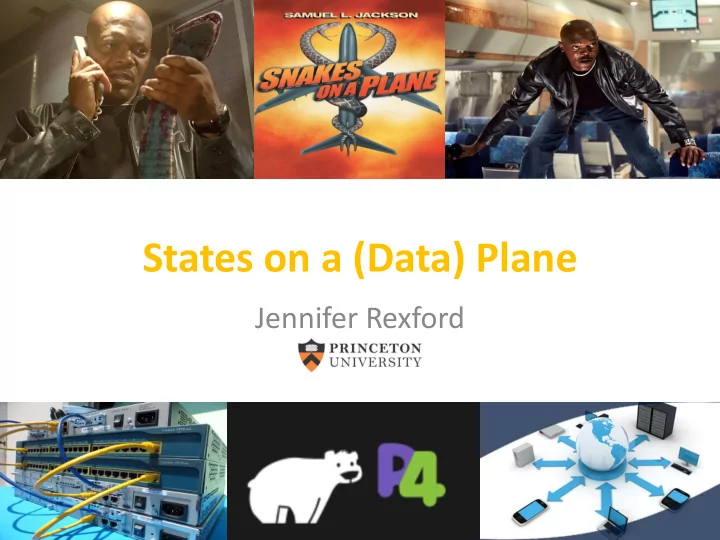

States on a (Data) Plane Jennifer Rexford
Traditional data planes are stateless 1
Software Defined Networks (SDN) Program your network from a logically central point! 2
OpenFlow Rule Tables action match Prio 1 dstip = 10.0.0.1 outport ← 1 2 dstip = 10.0.0.2 drop … … … 3
Two-Tiered Programming Model • Stateless data-plane rules – Process each packet independently – State updates are limited to traffic counters • Stateful control-plane program – Store and update state in the controller application – Adapt by installing new rules in the switches Forces packets to go to the controller… or greatly limits the set of applications 4
Emerging switches have stateful data planes 5
Local State on Data Plane Key Value H2 5 H1 99 … … 6
Local State on Data Plane Key Value H2 5 H1 100 … … 7
Local State on Data Plane Key Value match action value = 100 drop H2 5 H1 100 … … … … 8
Local State on Data Plane • Programmatic control over local state – P4, POF, OpenState, Open vSwitch • Plus other important features – Programmable packet parsing – Simple arithmetic and boolean operations – Traffic statistics (delays, queue lengths, etc.) • Simple stateful network functions can be offloaded to the data plane! 9
HULA Hop-by-Hop Utilization-aware Load-balancing Architecture Naga Katta, Mukesh Hira, Changhoon Kim, Anirudh Sivaraman, and Jennifer Rexford http://conferences.sigcomm.org/sosr/2016/papers/sosr_paper67.pdf 10
HULA Multipath Load Balancing S2 ToR 10 Data S3 S1 ToR 1 S4 • Load balancing entirely in the data plane – Collect real-time, path-level performance statistics – Group packets into “ flowlets ” based on time & headers – Direct each new flowlet over the current best path 11
Path Performance Statistics Best-hop table Best Next-Hop Path Utilization 0 S3 50% Dest 1 S4 10% ToR Probe … … … Probe S3 S1 Data Data S4 • Using the best-hop table – Update the best next-hop upon new probes – Assign a new flowlet to the best next-hop 12
Flowlet Routing Flowlet table Dest ToR Timestamp Next-Hop 0 ToR 10 1 S2 h(flowid) 1 ToR 0 17 S4 … … … … S3 S1 Data Data • Using the flowlet table S4 – Update the next hop if enough time has elapsed – Update the timestamp to the current time • Forward the packet to the chosen next hop 13
Putting it all Together data packet Best Next-Hop Path Utilization 0 S3 50% Dest ToR 1 S4 10% … … … current best Dest ToR Timestamp Next-Hop next-hop S3 Update next-hop ToR 10 1 S2 0 (if enough time ToR 0 17 S4 1 h(flowid) elapsed) and time … … … … chosen next-hop 14
Plenty of Other Applications • Stateful firewall • DNS tunnel detection • SYN flood detection • Elephant flow detection • DNS amplification attack detection • Sidejack detection • Heavy-hitter detection • … 15
But, how to best write these stateful apps? 16
SNAP: Stateful Network-Wide Abstractions for Packet Processing Mina Tahmasbi Arashloo, Yaron Koral, Michael Greenberg, Jennifer Rexford, and David Walker http://www.cs.princeton.edu/~jrex/papers/snap16.pdf 17
Writing Stateful Network Apps is Hard • Low-level switch interface – Multiple stages of match-action processing – Registers/arrays for maintaining state • Multiple switches – Placing the state – Routing traffic through the state • Multiple applications – Combining forwarding, monitoring, etc. 18
Snap Language • Hardware + ; independent • One Big Stateful Switch (OBSS) • Composition OBSS 19
Stateless Packet Processing • A function that specifies – How to process each packet on a one-big-switch – Based on its fields • E.g., NetKat set of input packet packets Function 20
Stateful Packet Processing • A function that specifies – How to process each packet on a one-big-switch – Based on its fields and the program state – Where state is an array indexed by header fields input packet set of SNAP packets Program current state updated state 21
Example Snap App: DNS Reflection • Seen: Keep track of DNS requests by client and DNS identifier • Unmatched : Count DNS responses that don’t match prior requests • Susp: Suspected victims receive many unmatched responses 22
Example Snap App: Stateless Forwarding ISP1 CS ISP2 EE 23
Composition ; 24
Snap Applications 25
Snap Compiler Composition of multiple apps Snap Compiler State placement and routing 26
Snap Compiler Identify State Dependencies Translate to Intermediate Representation (xFDD) Identify mapping from packets to state variables Optimally distribute the xFDD Generate rules per switch 27
Intermediate Representation: xFDDs • Canonical representation of a program • Composable • Easily partitioned • Simplify program analysis
Extended Forwarding Decision Diagrams (xFDDs) • Intermediate node: test on header fields dstip = 10.0.0.1 and state • Leaf: set of action srcip = dstip sequences s[srcip] = 2 • Three kinds of tests – field = value – field 1 = field 2 {s[dstip] ← 2} {drop} – state_var[e 1 ] = e 2 29
xFDD for DNS Reflection Detection 30
Optimally Distribute the xFDD Dependency Packet-State MILP Graph Mapping Output Traffic • State placement Matrix • Routing CS 31
See SIGCOMM’16 paper for prototype, experiments, etc. http://www.cs.princeton.edu/~jrex/p apers/snap16.pdf 32
More Fun With State • Extending Snap – More operations, e.g., field ← state[index] – Sharding and replication of state – Faster compilation • Richer computational model – Limits on computation per packet – Different memory (array, hash table, key-value store) – Hash collisions, delays in adding new keys, etc. • More stateful applications! 33
Conclusion • Emerging switches have stateful data planes – Can run simple network functions – … within and across switches! • Standard interfaces – E.g., P4 (p4.org) • Raises many new algorithmic challenges – New computational model – Compact data structures (e.g., sketches) – Working within hardware limitations 34
Recommend
More recommend